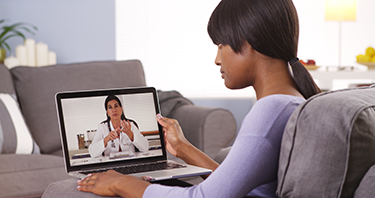6 Ways AV & Apps are Changing Healthcare

Technology fosters innovation which in turn makes businesses more competitive and productive. But beyond that, technology can connect employees, facilitate easier knowledge sharing, and empower workplaces for their employees. Healthcare is no exception. Here are six ways that emerging AV technologies and apps are influencing the very nature of healthcare.
Video technology is increasingly being used in hospitals to allow surgeons and other healthcare professionals to deliver real-time assistance to physicians in geographically separate locations via live steaming.
1) Making limited resources go further.
With NHS staff shortages here in the UK, and limited resources and budgets in the developing countries, it’s never been more important for healthcare organizations to be able to leverage existing means to accomplish more. Having the ability to test, diagnose, monitor, deliver hands-on training, and even interactively guide remotely is a great breakthrough.
2) Using streaming video for real-time assistance.
Video technology is increasingly being used in hospitals to allow surgeons and other healthcare professionals to deliver real-time assistance to physicians in geographically separate locations via live steaming. This technology enables an operating surgeon to carry out surgery with live, interactive consultations from a remote colleague or instructor, providing the potential to enhance education and transfer knowledge, but also to tackle the increasing problem of staff shortages. Geographical barriers are torn down, as there is no need for the more experienced surgeon to travel, which would most certainly delay the procedure to the detriment of the patient.
3) Addressing a skills shortage.
Last year, Guy’s and St Thomas’ Hospitals in London announced that they were about to start trialing the use of video technology to monitor and check on critically ill patients from another hospital and alert on-site staff should a problem arise. Not only would this move tackle the problem of skills shortage but also improve the standards of care at night or during weekends when it is predominantly junior doctors who are on shift. Video technology could eventually even allow healthcare professionals to check their patients’ conditions from home.
4) Google Glass in the OR.
Surgeons in the U.S. have started using Google Glass to stream their operations online, share medical images in their fields of expertise and consult with peers who can follow the surgery live via video link. An orthopedic surgeon at Ohio State University’s Wexner Medical Center was the first in the U.S. last year to bring Google Glass into the operating room and more and more surgeons have since begun doing the same. Not only is this an incredibly effective way to educate medical staff and students but, as the technology can be used remotely, it could also potentially spread medical knowledge and care to places in the world where they currently do not have it.
5) Mobile apps for remote, affordable eye care.
Another great example of technology being harnessed to spread knowledge and allow people to do things they would otherwise not be able to do due to lack of means is PEEK (Portable Eye Examination Kit).
A daily selection of features, industry news, and analysis for tech managers. Sign up below.
PEEK, winner of the digital category of the 2014 Designs of the Year Award, is an easy to use, inexpensive, smart-phone based system utilized to perform eye tests anywhere in the world—even in the remotest of regions.
In most developing countries it is still incredibly challenging to provide basic healthcare, especially to people living in isolated zones. PEEK can give access to critical eye care by empowering health professionals to test, diagnose, and assess what best course of treatment is needed.
This simple app allows individuals with minimal training to perform a thorough examination. The smartphone and the images it produces replace more traditional equipment which is both bulky and expensive, and which cannot therefore be easily moved between locations. The smartphone can travel with the healthcare professional to the patient which could never happen if traditional equipment was involved.
Cost reduction is an added benefit: instead of requiring a team of many trained professionals with expensive equipment to travel to the patient, the examination can now be carried out by a single healthcare professional with a smartphone. All images are then studied remotely by the larger team of experts who receive them and then enable the local professional to arrange treatment.
This is a great example of effective mobile technology and of what images and a mobile device can help achieve, even long-distance. Knowledge is brought to you and not the other way around.
6) Training via video.
Video and mobile technology go hand-in-hand and they can be very powerful tools when it comes to training and development. Video enables experienced surgeons to learn new techniques but also to showcase them to students or junior doctors. Video training can be provided in-residence and on the spot, with professionals in the operating theatre being guided through more complex emergency procedures.
Thanks to mobile technology, training via video can be delivered anywhere, any time, and on any device. People can access a session at a time most convenient to them, irrespective of time zones, even when on the move, commuting into and out of work or waiting in airport lounges while travelling. It is the next best experience to "being there."
Video makes it possible for knowledge to be more easily shared and transferred which can make a huge difference to healthcare provision in poorer countries.
Video technology has become ubiquitous and it is now part of all aspects of our lives, be it personal or professional. It can make life easier, spread and impart knowledge, improve care, shorten waiting times and, more importantly, empower healthcare professionals to help where they previously simply could not. The possibilities are endless.
